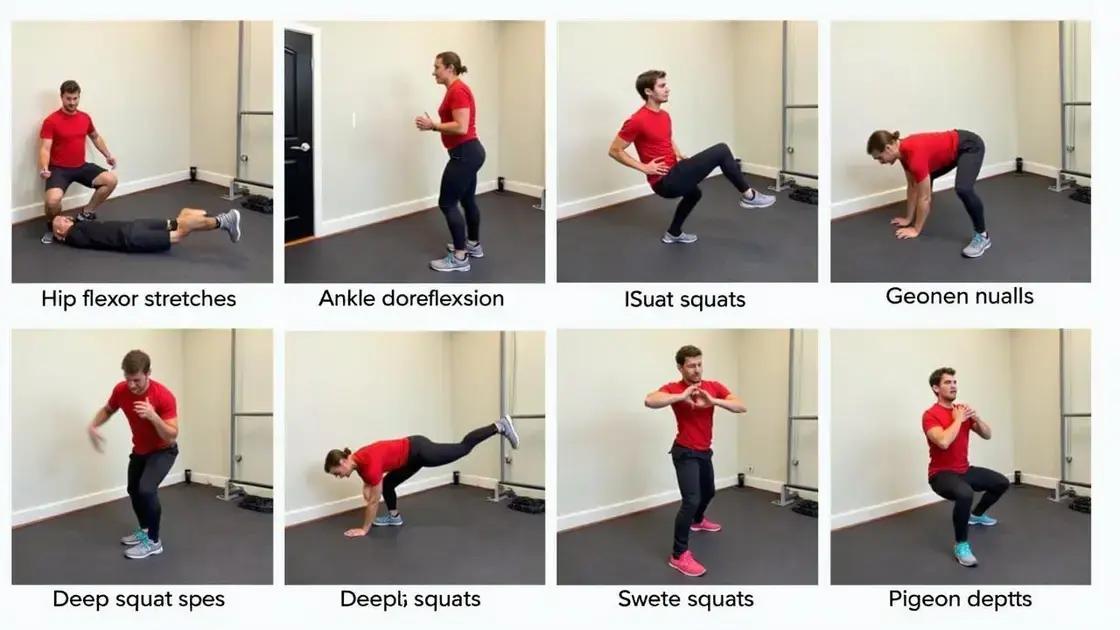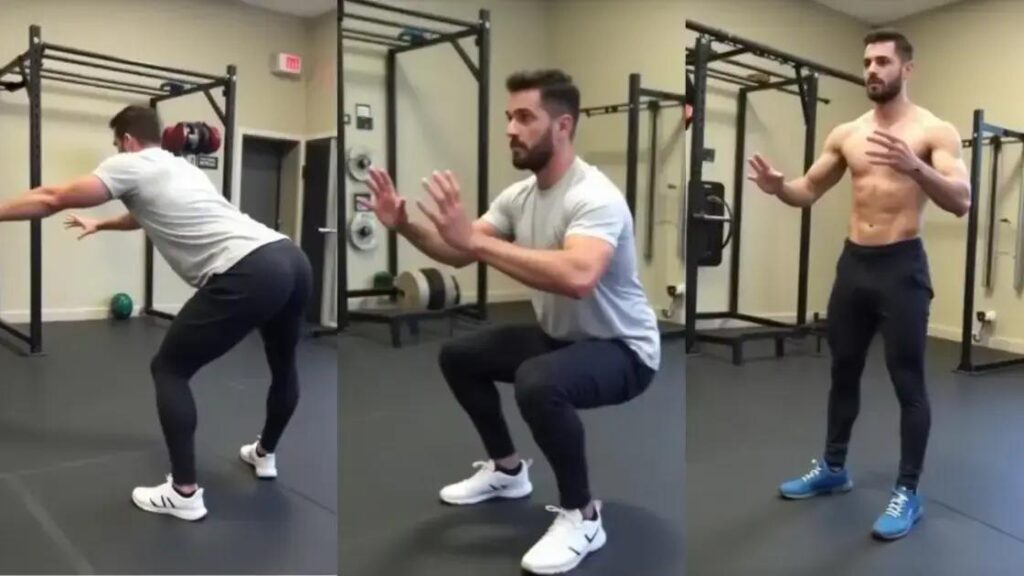To improve squat depth effectively, incorporate mobility drills such as hip flexor stretches, ankle dorsiflexion, and deep squat holds into your routine. Regularly measuring progress through video analysis and maintaining a workout journal will help track improvements and enhance overall performance.
Improving your squat depth is essential for lifting effectively and safely. Best mobility drills to improve squat depth can help you achieve that goal. Whether you’re a beginner or an experienced lifter, enhancing your mobility will lead to better performance in the gym. In this article, we’ll explore various mobility drills, how they contribute to improved squat depth, and tips for integrating them into your workout. Let’s dive in and optimize your squatting technique!
Understanding Squat Depth and Mobility

Squat depth is crucial for effective lower body workouts. It refers to how low you can go in a squat without compromising form. Proper squat depth contributes to strength, flexibility, and mobility. When it comes to squatting, deep squats can engage various muscles, including the quadriceps, hamstrings, and glutes.
The Importance of Mobility
Mobility is the ability to move your joints through their full range of motion. Good mobility allows you to achieve better squat depth. This is because tight muscles can limit how low you can go. For instance, tight hip flexors, calves, or ankles can hinder your squatting ability.
Factors Affecting Squat Depth
There are different factors that influence your squat depth. Body mechanics play a massive role, including your anatomy and limb lengths. Your individual flexibility also affects how deep you can squat. Furthermore, previous injuries can lead to compensations that limit squat depth.
Benefits of Achieving Proper Squat Depth
Achieving proper squat depth helps you improve your overall strength and athletic performance. It engages more muscle fibers and can lead to better stability. Additionally, deep squats can enhance flexibility, which can prevent injuries in the long run. Overall, understanding squat depth and mobility gives you the foundation needed to progress further in your training.
Top Mobility Drills for Depth Improvement

To improve your squat depth, incorporating specific mobility drills is essential. Here are some of the top drills that can help:
1. Hip Flexor Stretch
This stretch targets tight hip flexors that can limit squat depth. Start in a lunge position, place your back knee on the ground, and push your hips forward to feel a stretch.
2. Ankle Dorsiflexion Drill
Stand with your feet shoulder-width apart. Keeping your heel on the ground, bend your knee forward over your toes. This drill improves ankle mobility, which is crucial for deeper squats.
3. Goblet Squat
Hold a dumbbell or kettlebell close to your chest and squat down. The added weight helps reinforce proper squat form while simultaneously enhancing mobility.
4. Deep Squat Hold
Assume a deep squat position and hold it for 30 seconds to a minute. This passive stretch lengthens hip muscles and increases comfort in the squat position.
5. Pigeon Pose
This yoga pose helps stretch the glutes and hip rotators. Sit on the ground, crossing one leg and gently lowering your torso towards the ground.
Incorporating these mobility drills into your routine can greatly enhance your squat depth, leading to better performance and reduced injury risk during workouts.
Incorporating Drills into Your Routine

Incorporating mobility drills into your workout routine is important for enhancing squat depth. Here are some practical tips to help you integrate these drills effectively:
Schedule Regular Practice
Set aside specific days for mobility training. Aim for at least 2-3 times a week to see noticeable improvements. You can include drills as part of your warm-up or cool-down sessions.
Combine with Strength Training
Incorporate mobility drills alongside your strength-training exercises. For example, perform a mobility drill before your squats to prepare your muscles. This helps improve performance during your lifting routine.
Use a Timer
When practicing mobility drills, use a timer to ensure you dedicate enough time to each exercise. Aim for 30 seconds to 1 minute per drill, allowing for transitions between movements.
Track Your Progress
Keep a journal to track your mobility improvement over time. Note how your squat depth changes and how your body feels after incorporating these drills into your routine. This helps you stay motivated and adjust your plan as needed.
Stay Consistent
Consistency is key when it comes to improving mobility. Make these drills a routine habit. Over time, you will notice significant benefits in your squat depth and overall performance.
Measuring Progress in Squat Depth

Measuring your progress in squat depth is vital to understand how effective your mobility drills are. Here are some methods to track your improvements:
Video Analysis
Record yourself performing squats from different angles. Watching your form can reveal changes in squat depth. Compare older videos to new ones to visually assess improvement.
Use a Measuring Stick
Place a measuring stick or a tape on the wall next to where you squat. Mark the depth you can achieve. This gives you a clear visual to track progress over time.
Regular Testing
Set aside specific days to test your squat depth. Use a consistent method to ensure accuracy. This could be a foundational test at the end of each month to see how drills affect your squatting.
Record Your Workouts
In your workout journal, note the depth you achieve each session. Write down how you feel and any improvements after practicing mobility drills. This helps keep you focused and motivated.
Get Feedback
Consider asking a trainer or a workout buddy to observe your squats. Their feedback can provide insights into your progress and areas that need more attention.
Improving Squat Depth: A Path to Better Performance
Improving your squat depth through effective mobility drills can enhance overall athletic performance and reduce the risk of injury. By understanding the fundamentals of squat depth and mobility, you can choose the right drills that fit your needs.
Incorporating these drills into your routine regularly will set a strong foundation for your squatting abilities. Moreover, tracking your progress is vital in staying motivated and making necessary adjustments to your training. By leveraging video analysis, regular testing, and feedback, you will see marked improvements over time.
Remember, achieving your squat depth goals is a gradual process, and consistency is key. Stay committed to the drills, measure your progress, and enjoy the journey to becoming a stronger, more capable athlete.
FAQ – Frequently Asked Questions about Improving Squat Depth
What are mobility drills?
Mobility drills are exercises designed to enhance the range of motion in your joints and muscles, helping improve your flexibility and strength, especially for squats.
How often should I perform mobility drills?
It’s recommended to incorporate mobility drills into your routine 2-3 times a week, ideally as part of your warm-up or cool-down.
How can I measure my squat depth progress?
You can measure your squat depth by using video analysis, taking measurements against a stable object, or keeping a workout journal to track depth and feelings about each session.
Why is squat depth important?
Proper squat depth ensures that you engage the right muscles effectively, improving strength, performance, and reducing the risk of injury.
Can I do mobility drills at home?
Yes, many mobility drills can be performed at home with little or no equipment. They can easily be integrated into your daily routine.
What if I have pain while trying to improve my squat depth?
If you experience pain, it’s important to consult a healthcare professional or a qualified trainer to assess your form and identify any potential issues.












